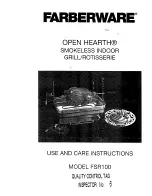
- 13 -
USE
INSTRUCTIONS FOR USE
Fig. 2.5
11
12
13
The LCD display displays the boiler temper
-
ature (primary circuit) and
symbol;
the
symbol slowly flashes Fig. 2.6
.
Fig. 2.6
°C
2.4 C.h. circuit temperature
The output temperature of c.h. water can be
adjusted by acting on keys 12 (reduce) and
13 (increase) (Fig. 2.5) from a minimum of
about 25°C to a maximum of about 85°C.
Press one of the two keys once to display
the "set" value. Press again to access the
modification.
Signal given by the LCD display:
•
The heating hot water flow "set" temper
-
ature and the symbol
flash. The
background of the display is illuminated
(Fig. 2.7).
Fig. 2.7
°C
Adjustment of temperature WITHOUT
the external temperature probe (option
-
al) fitted
Adjust the c.h. water flow as follows:
•
from 25 to 35 with an external tempera
-
ture included between 5 and 15°C;
•
from 35 to 60 with an external tempera
-
ture included between -5 and +5°C;
•
from 60 to 85 with an external tempera
-
ture less than -5°C.
Your qualified installer can recommend the
most indicated adjustments for Your sys
-
tem.
The control of the set temperature reached
can be seen on the LCD display by means
of the missing symbol
.
Power request in c.h. power.
When the boiler has a power request in the
c.h. mode, the symbol is displayed on
the display followed by an increase of the
c.h. water flow temperature. The
symbol flashes ( Fig. 2.8).
Fig. 2.8
°C
Adjusting the c.h. temperature with the
external temp. probe installed
When the external temp. probe (optional)
is installed your boiler automatically adjusts
the temperature of the c.h. system water
flow in relation to the external temperature.
In this case the boiler must be set by a qual
-
ified installer (see "Setting the K coefficient
of the external temperature probe" to page
57).
However, if the ambient temperature is not
comfortable, the flow temperature of the
heating plant can be increased or reduced
by ± 15°C by acting on keys 12 (reduce)
and
13 (increase) (Fig. 2.5).














































